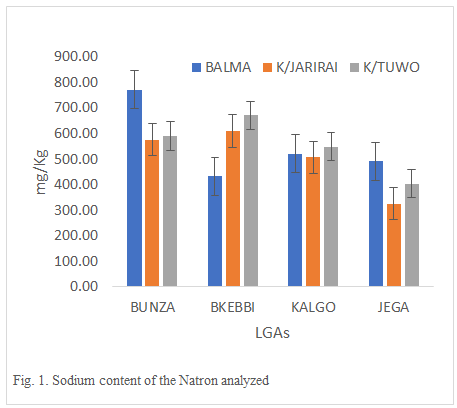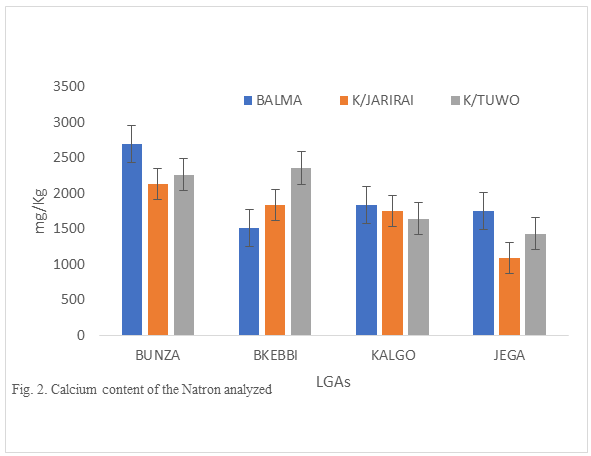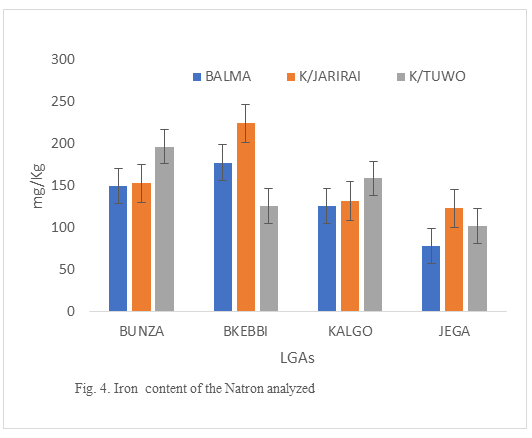Analyses of the Elemental Content of three Brands of Natron in Four Local Government Areas in Kebbi State
- Shemishere, U. B.
- Aliyu, H.
- Anyebe, A. D.
- Erhovwosere, O.
- Aghayere, F.
- Jaboro G
- Taiwo, J. E.
- 284-290
- Mar 18, 2024
- Education
Analyses of the Elemental Content of three Brands of Natron in Four Local Government Areas in Kebbi State
*Shemishere, U. B.1, Aliyu, H.2, Anyebe, A. D.3, Erhovwosere, O.4, Aghayere, F.5, Jaboro G6 and Taiwo, J. E.7
1,2,3Department of Biochemistry and Molecular Biology, Federal University Birnin Kebbi, Birnin Kebbi, Kebbi State
4,5,7Department of Biochemistry, University of Benin, Benin City, Edo state.
6Precious Life Medical Centre, Abuja, FCT.
*Corresponding Author
DOI: https://doi.org/10.51584/IJRIAS.2024.90224
Received: 25 January 2024; Revised: 08 February 2024; Accepted: 13 February 2024; Published: 18 March 2024
ABSTRACT
Natron is the second most consumed salt in Nigeria. It is used as a food additive to cook beans, maize, and other palatable foods. Several studies have investigated the elemental content in this salt in Nigeria. However, there is paucity of information on the elemental content of this widely consumed salt in Kebbi State. Thus, this study is focused on the analyses of elemental content in Natron in sold in four Local Government Areas (LGAs) of Kebbi State. Three brands of Natron were collected from markets in Birnin Kebbi, Jega, Kalgo and Bunza local governments. Atomic Absorption Spectroscopy (AAS) was used to analyse the elemental content. Furthermore, the elemental content values were collated for the samples of the different brands of Natron. The sodium content of the Kanwa Jarirai brand in Jega had the lowest sodium content of while the Balma brand in Bunza had the highest sodium content of . All three Natron brands investigated in the four LGAs exceeded the World Health Organization (WHO) permissible limit for potassium, iron and, manganese levels. All the brands of Natron did not satisfy the adult daily calcium intake except for the Kanwa Jarirai from Jega with . Moreso, all the three brands in the selected four LGAs satisfied the sodium permissible WHO limits. The iron, manganese, and potassium WHO permissible limits were not met. In addition, the Natron from the four LGAs did not satisfy the adult daily intake of calcium except the Kanwa Jarirai from Jega. Consumers will need to be cautious of the usage of the analysed Natrons as they contained high levels of sodium which might not be beneficial to cardiovascular health.
Keywords: kanwa; Elemental content; Natron; Atomic Absorption Spectroscopy; Kebbi -State
INTRODUCTION
Natron is widely used in Northern Nigeria for medicinal purposes, as a herbal concoction for cough treatment, and also as a tenderizing agent for the preparation of local dishes [1]. High amount of Natron could cause severe and irreparable kidney damage [2]. In addition, excess ingestion of Natron has been shown to lead to cardiomyopathy [3]. Studies have revealed that Natron is the second most widely used salt in Nigeria. Natron, generally is used to refer to a group of potassium-containing minerals and chemicals. High consumption of Natron is prevalent in Northern Nigeria during postnatal care which causes peripartum cardiomyopathy [4]. Natron has been reported to contain high elemental sodium content [5]. High consumption of food with high sodium content is harmful to hypertensive patient. Several literatures have studied the elemental content in Natron. Imafidon et al [5] evaluated the elemental contents of Natron sold in Benin, Edo State Nigeria. Results from their study showed that the Natron purchased from Benin, Nigeria had high content of sodium, and iron. In addition, injurious heavy metals like cadmium, zinc and lead were detected. Saidu et al., [6] examined the consequence of Natron in post-delivery Wistar albino rats. Their study reveals that Natron purchased from Sokoto, Nigeria, had effects on the heart of rats after delivery. Garba et al [7] examines the radiological content of Natron used in Nigeria. The Farar Kanwa, Jan Kanwa, Dan Libya, Ngurnu, Manda, Farar Balma, Jar Balma and Yar Agadez brands were identified and purchased from the Zaria market in Kaduna, Nigeria. The radium equivalent activity, annual effective dose, internal and alpha hazard and total cancer risks metrics were used to assess the radiological safety of its consumption. Results from the study affirms that there are no radiological concerns at the present threshold. However, a slight increase in the threshold may lead to significant radiological health concerns. Natron orally administered at high doses has been shown to alter tissues morphology and induce hepatotoxicity and nephrotoxicity [2][5]. Investigation into the elemental contents of Natron in different part of Nigeria has revealed that Natron is rich in different mineral elements and traces of heavy metals, some of which are above the WHO permissible limits [8][9][10].
The literature reviewed have carried out various analysis on Natron consumed in various locations in Nigeria. However, there is lack of studies on the elemental content, and the interaction effect between location and brand of Natron consumed in Kebbi-State, which is a Northwestern state in Nigeria. Thus, the aim of this study was to analyze the elemental content of Natron consumed in selected LGAs in Kebbi-State, Nigeria and to ascertain whether the values of the elemental content in the four selected LGAs were within the standard permissible limits designed by WHO.
MATERIALS AND METHODS
Kebbi-State
At 350 meters above sea level, Kebbi-State is located in the Sudan Savannah vegetation zone [9]. Two distinct seasons, wet and dry, defines the climate [11], [12]. Beginning in May/June and ending in September/October is the wet season. The dry season is from October to April/May [11]. The range of the mean annual rainfall is 500 to 700 mm, with larger interannual variability. During the rainy season, relative humidity ranges from moderate to high , and very low in the dry season. There is huge temperature variations from in December/ January to about in April with annual mean of [11].
Source of materials
Three samples of Natron brands (Balma, Kanwa Jarirai, and Kanwa Tuwo) were purchased from markets in the four selected LGAs of Kebbi-State, Nigeria.
Elemental content analysis
The simple and economical AAS was used to analyse the elemental content according to [10], [13]. The elemental content analysed were; sodium, calcium, potassium, iron, and manganese. These elemental contents are indispensable for human development [14]. Sodium is indispensable for humans. It regulates blood pressure and blood volume. In addition, it is important for muscle and nerve function. The recommended daily intake for sodium is for children between the ages of and for adults between the ages of [15]. The permissible WHO limit for sodium in Natron is [10].
Calcium is generally deposited in the bones and teeth. It is also important for muscle contraction, nervous system function, expansion and contraction, and secretion of hormones and enzymes [16]. The acceptable calcium intake for adults is [14], this is dependent on age and gender. High consumption of calcium lowers blood pressure. In addition, some enzymes cannot work efficiently in the body without calcium. Thus, they are co-factors for many enzymes. The parathyroid gland is responsible for controlling calcium in the blood. Overreactive parathyroid gland disrupt the balance of calcium in the body. High calcium in the body is hypercalcemia, in contrast, low calcium in the body is hypocalcaemia. Hypercalcemia leads to poor bone health, pancreatitis, kidney stones, and abnormal heart and brain function.
Potassium is the third most abundant mineral in the human body and is essential to human life. It is necessary for normalizing body cells, regulating heartbeat, ensuring proper function of muscles and nerves. Additionally, it is important for metabolizing carbohydrates, and synthesizing protein. The permissible WHO limit of potassium in Natron is [10]. Hyperkalaemia occurs when the potassium level in the blood is high, as this lead to damage of the heart and occurrence of heart attack.
Majority of the Iron in our body is in heme proteins like haemoglobin and myoglobin, both involved in oxygen transport. Iron is also found as a constituent of heme enzymes like cytochromes, catalases and peroxidizes, and other non-heme compounds [16]. The permissible WHO limit of iron in Natron is [10]. Much absorption of iron from the food consumed leads to hemochromatosis. Excess iron is stored in the human organs especially the liver, heart and pancreas. Hence, this leads to liver problems, heart problems, and diabetes because of damaged pancreas.
Manganese is indispensable for human beings. It functions as an enzyme activator for several enzymes and as an element of some metalloenzymes [17]. The permissible WHO limit of Manganese in Natron is [10]. Manganese toxicity leads to tremors, muscle spasms, hearing problems, mania, insomnia, depression, loss of appetite, headaches, irritability, weakness, and mood changes.
Statistical analysis
Results are presented in Mean ± standard error of mean. Where applicable statistical analysis of variance (ANOVA) was used to determine level of significance between Natron brands and the locations with p < 0.05 considered as significant.
RESULTS AND DISCUSSION
Elemental contents Analyses of the three Natron brands in the selected LGAs.
The sodium content of the three brands is presented in Fig. 1. The Balma brand in Bunza had the highest sodium content of 770.50 mg/Kg . The WHO permissible limit for sodium content is 6065 mg/Kg [10]. The Kanwa Jarirai from Jega has the lowest with 325.07 mg/Kg.
It is interesting to note that the results in Fig. 1 showed that the three brands from the four LGAs had sodium contents that were within the WHO acceptable range. Previous reports [10] revealed that the elemental level of salt was higher than the WHO recommended limit. The location and range of Natron brands could be the cause of this. Similar outcomes, meeting the WHO-permissible salt concentration, were seen in the trial conducted by [8]. Nevertheless, the Natron brands examined by [8] were omitted.
Fig. 2 shows the calcium content of the three brands. With 2695.56 mg/kg of calcium, the Balma brand in Bunza had the highest concentration. Adults should consume between 1000 and 1300 mg of calcium daily [14].
From Fig. 2, it is interesting aspect that emerged from the analysis is that only the Kanwa Jarirai from Jega satisfies the daily intake of calcium permissible daily, although calcium intake is subject to age and gender. An equally large difference has been observed by the calcium content in this study and [10].
Fig. 3 shows the potassium concentration of the three brands. 100 mg/kg is the acceptable potassium limit in Natron [10]. The potassium concentration clearly demonstrates a tendency of increasing when compared to the WHO acceptable limit (Figure 3). With 1806.46 mg/kg of potassium, Bunza’s Balma Natron brand had the highest potassium content, while Jega’s Kawan Jarirai had the lowest at 725.06 mg/kg. This rise may be the result of wind impact causing fine compound loss, which paves the way for massive aggregate pavement in the areas surrounding archaeological sites. Furthermore, this is due to the presence of high temperatures in regions where evaporation exceeds precipitation, potentially causing moisture loss from the Natron beds [9],[18].
The iron content of the three brands is presented in Fig. 4. WHO iron content permissible limit is 30 mg/Kg[10]. The result of this analysis for iron content in Fig. 4 shows that Birnin-Kebbi’s Kanwa Jarirai had the highest value of 224.13 mg/Kg while Jega’s Balma had the lowest iron content of 78.4 mg/Kg.
The manganese content of the three brands is presented in Fig. 5. The WHO manganese permissible limit is 10 mg/Kg. As can be seen in Fig. 5 the Kanwa Tuwo recorded the highest manganese content with 66.37 mg/Kg while Balma from Jega had the lowest manganese content with 16.67 mg/Kg. The manganese content of the three brands in the four selected LGAs WHO permissible limit is not met. This is due to the occurrence of high temperatures in areas where evaporation exceeds precipitation and moisture is lost from the Natron beds [9], [18]. The interaction of the factors (LGAs and Natron brand) statistical analysis on the elemental content is imperative. Finding out whether there are significant differences between the group (columns) and sample (Natron) analyzed by using variance is the purpose of this analysis. In Tables (1) – (5) sample refers to the brand of Natron, columns are the location (LGA), interaction refers to the interactions between the LGAs and Natron brands.
This study is focused on the analyses of selected elemental contents in Natron of three brands used in four LGAs in Kebbi-State Nigeria. Taken together, these findings suggest that all the three brands in the selected four LGAs met the sodium permissible WHO limits. However, the iron, manganese, and potassium WHO permissible limits were not met. The Natron brands from the four LGAs did not met the daily adult intake consumption of calcium except the Kanwa Jarirai from Jega. In addition, there is interaction between the Natron brands and the selected LGAs at 95% confidence interval. The significance of this study lies in the analyses of elemental content of Natron consumed in selected LGAs in Kebbi-State. The present study has only investigated Natron brands in Bunza, Birnin-Kebbi, Kalgo, and Jega. Therefore, future studies should consider more populated LGAs like Zuru, Argungu, Aliero, and so on. This study has revealed that the iron, manganese, and potassium contents in Natron consumed in the selected LGAs did not meet the WHO permissible limit. Future studies should focus on the analyses of injurious elemental content.
Funding
The study was sponsored by the authors’ individual efforts rather than by any funding agency.
DATA AVAILABILITY
The data that support the findings of this study are available in Open Source Framework at https://osf.io/9qth6.
Conflict of interest
The authors have no conflict of interest to declare.
REFERENCES
- Y. Saidu, R. O. Olaosebikan, S. A. Isa, I. Malami, and S. A. Muhammad, “Effect of Natron administration on the antioxidant status and lipid profile of rats,” J. Food Sci., vol. 85, no. 11, pp. 4033–4038, 2020, doi: 10.1111/1750-3841.15480.
- T. S. Imam, A. Sani, and A. Hassan, “Heavy metals in blood and histopathological analysis of Wistar rats exposed to five Natron (kanwa) varieties sold in Kurmi Market Kano, Northern Nigeria,” FUDMA J. Sci., vol. 3, no. 3, pp. 472–481, 2019.
- A. L. Abubakar, J. A. Danyaya, K. Abubakar, M. U. Faruk, and Y. Saidu, “Effect of Guiera senegalensis and Natron on Serum Indices of Cardiac Function of Postpartum Rats,” J. Adv. Biol. Biotechnol., vol. 24, no. 7, pp. 32–46, 2021, doi: 10.9734/jabb/2021/v24i730226.
- S. A. Isezuo and S. A. Abubakar, “Epidemiologic profile of peripartum cardiomyopathy in a tertiary care hospital. Ethnicity & Disease,” vol. 17, no. 2, pp. 228–233, 2007.
- K. E. Imafidon, I. D. Egberanmwen, and I. P. Omoregie, “Toxicological and biochemical investigations in rats administered ‘kaun’ (trona) a natural food additive used in Nigeria,” J. Nutr. Intermed. Metab., vol. 6, pp. 22–25, 2016, doi: 10.1016/j.jnim.2016.05.003.
- Y. Saidu et al., “Biochemical and histological changes in the heart of post-partum rats exposed to Natron,” Indian Heart J., vol. 70, no. 6, pp. 887–893, 2018, doi: 10.1016/j.ihj.2017.12.002.
- N. N. Garba, H. J. Ibrahim, and R. A. Onoja, “Radiological safety assessment of mined Trona commonly consumed in Nigeria Radiological safety assessment of mined Trona commonly consumed in Nigeria,” Int. J. Environ. Anal. Chem., vol. 00, no. 00, pp. 1–11, 2020, doi: 10.1080/03067319.2020.1849658.
- I. Katuzu, I. A. Hodi, and M. Amina, “Physicochemical and elemental analysis of potash (mangul) sold in Damaturu sunday market, Yobe state,” Int. J. Pure Appl. Sci. Publ., vol. 20, no. 9, pp. 1–9, 2021.
- A. Abdulkarim, K. M. Aljameel, S. A. Maigandi, and Y. Na-Allah, “Laboratory Assessment of Different Kanwa-Based Mineral Lick for Ruminant Nutrition,” J. Appl. Life Sci. Int., vol. 25, no. 7, pp. 17–24, 2022, doi: 10.9734/jalsi/2022/v25i7590.
- A. Uba et al., “Physicochemical and Elemental Analysis of Different Brands of Natron and Potash in Sokoto State,” IOSR J. Appl. Chem., vol. 9, no. 6, pp. 51–54, 2016, doi: 10.9790/5736-0906025154.
- S. Umar, W. Kabiru, J. Umar, S. Danjuma, A. Ifatokun, and P. Ifabiyi, Hydrochemical characterization of shallow and deep groundwater in Basement Complex areas of southern Kebbi State , Sokoto Basin , vol. 9, no. 8. Springer International Publishing, 2019.
- S. A. Omoleke et al., “Environmental , economic and socio-cultural risk factors of recurrent seasonal epidemics of cerebrospinal meningitis in Kebbi state , northwestern Nigeria : a qualitative approach,” BMC Public Health, vol. 18, no. Suppl 4, 2018.
- D. A. Skoog, F. J. Holler, and S. R. Crouch, Principles of instrumental analysis. Cengage learning, 2007.
- M. . Mohammed and U. M. Ahmad, “Mineral elements content of some coarse grains used as staple food in Kano metropolis, Nigeria,” Bayero J. Pure Appl. Sci., vol. 7, no. 1, pp. 85–89, 2014, doi: http://dx.doi.org/10.4314/bajopas.v7i1.16.
- FNB, “Dietary Reference Intakes (DRIs): Recommended Intakes for Individuals, Vitamins.,” 2013.
- L. R. McDowell, Minerals in Animal and Human Nutrition. Academic Press Inc., CA, USA., 1992.
- J. Crossgrove and W. Zheng, “Manganese toxicity upon overexposure,” NMR Biomed., vol. 17, pp. 544–553, 2004.
- G. Palache, A. Charles, and G. . Berman, Frondel H. Dana’s System of Minerology, 7th ed. Wiley, 1951.





